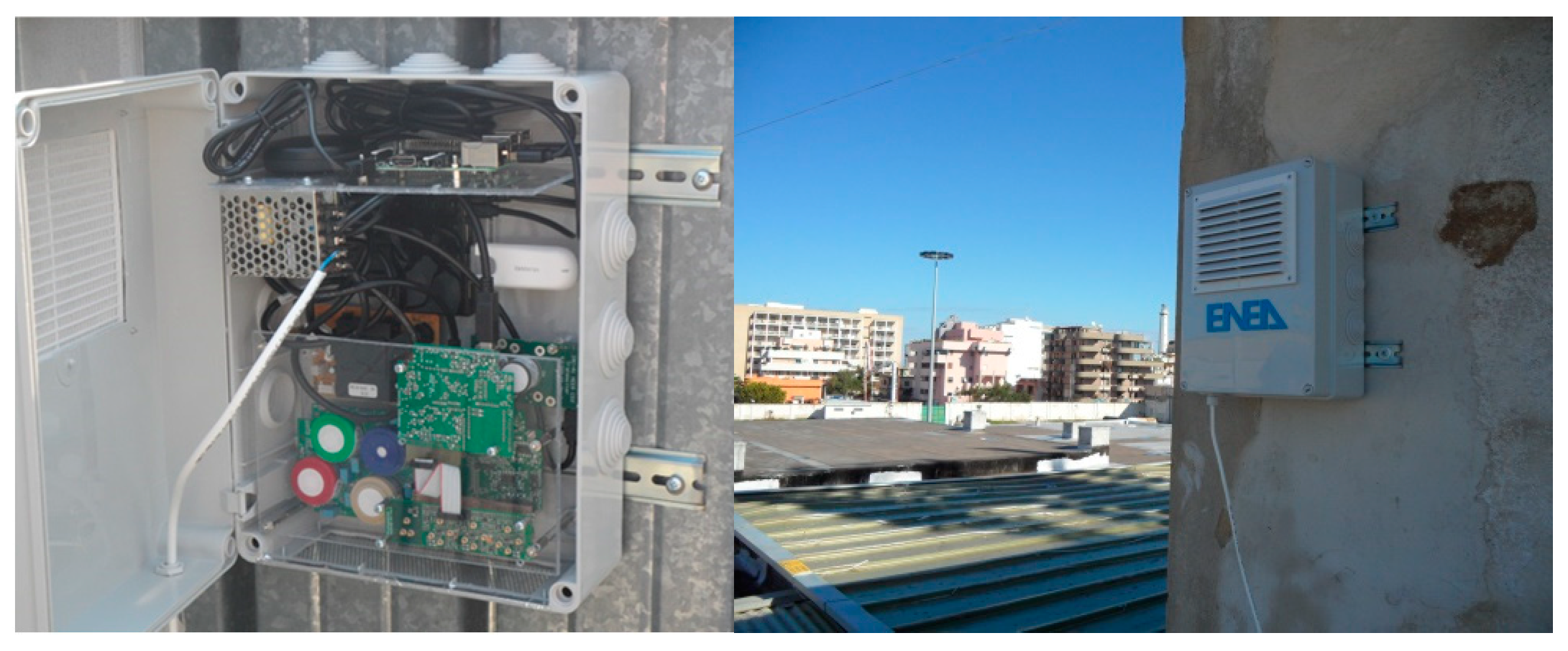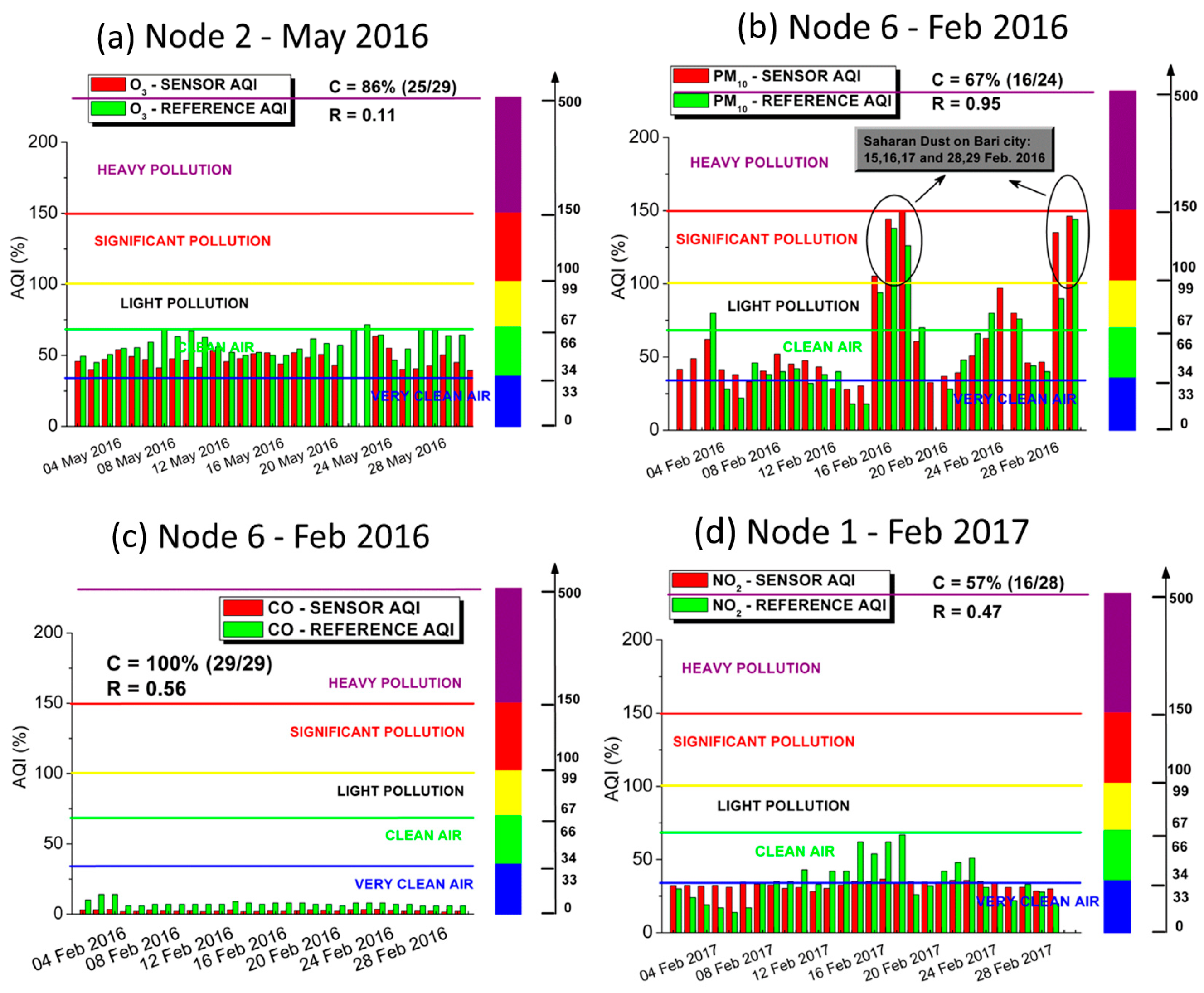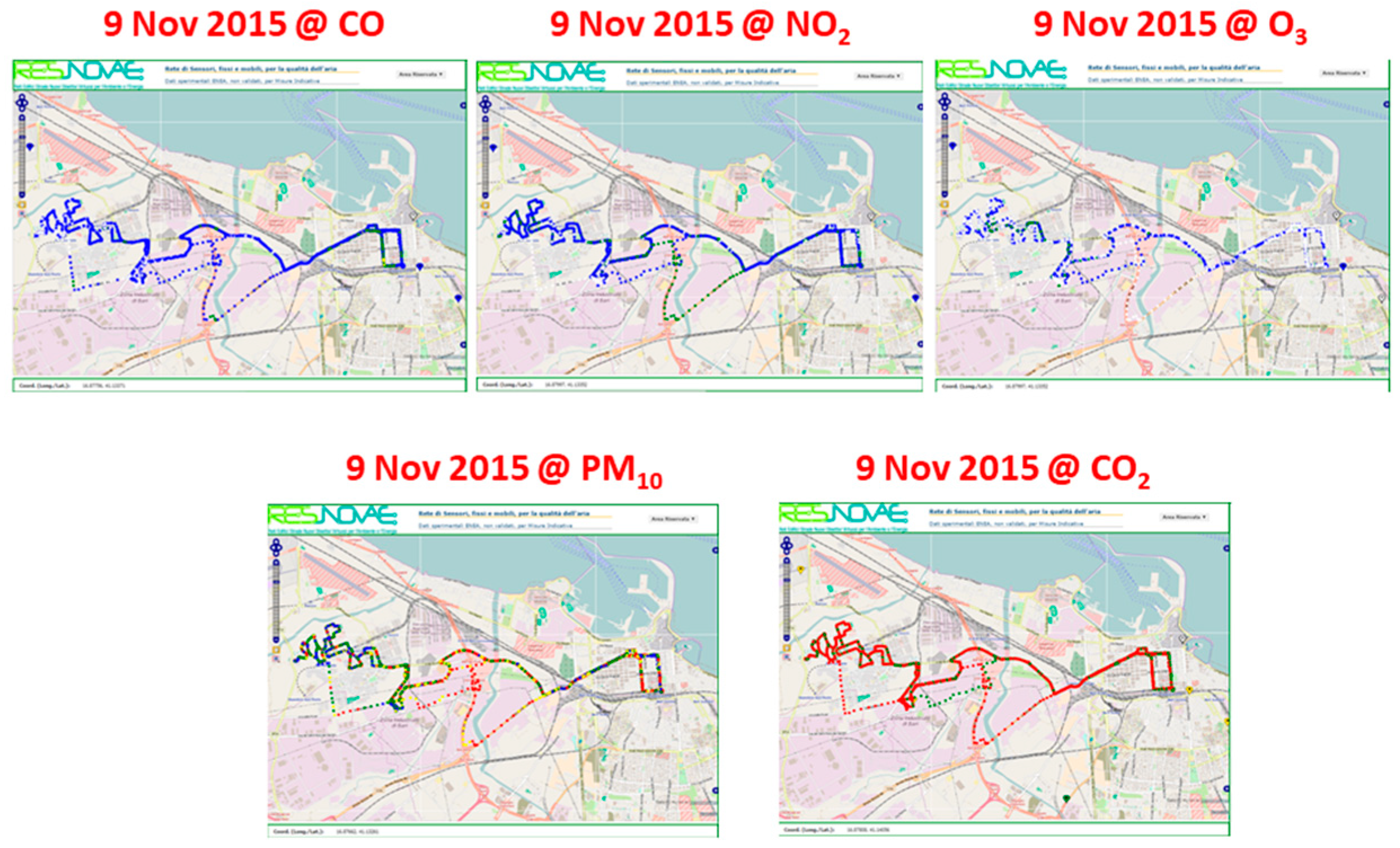Application of Low-Cost Sensors in Stationary and Mobile Nodes for Urban Air Quality Index Monitoring †
Abstract
:1. Introduction
2. Materials and Methods
2.1. Air Sensors Used and Electronics
2.2. Definition of Air Quality Index (AQI) and Classification Rate
3. Results and Discussion
3.1. Air Quality Index by Stationary Sensor Nodes
3.2. Air Quality Index by Mobile Sensor Node
4. Conclusions
Author Contributions
Funding
Institutional Review Board Statement
Informed Consent Statement
Data Availability Statement
Acknowledgments
Conflicts of Interest
References
- United Nations Environment Programme (UNEP) Frontiers 2016 Report. Emerging Issues of Environmental Concern; UNEP: Nairobi, Kenya, 2016; ISBN 978-92-807-3553-6.
- European Environment Agency (EEA). Air Quality in Europe—2023 Report. Available online: https://www.eea.europa.eu/publications/europes-air-quality-status-2023 (accessed on 20 July 2023).
- World Health Organization. Air quality guidelines for particulate matter, ozone, nitrogen dioxide and sulfur dioxide. In Global Update 2005. Summary of Risk Assessment; World Health Organization: Geneva, Switzerland, 2006. [Google Scholar]
- Ambient Air Quality and Clean Air for Europe—EU Directive 2008/50/EC. Available online: http://eur-lex.europa.eu/legal-content/EN/TXT/PDF/?uri=CELEX:32008L0050&from=en (accessed on 20 July 2023).
- Penza, M.; Suriano, D.; Pfister, V.; Prato, M.; Cassano, G. Urban air quality monitoring with networked low-cost sensor-systems. Proceedings 2017, 1, 573–577. [Google Scholar]
- Williams, R.; Duvall, R.; Kilaru, V.; Hagler, G.; Hassinger, L.; Benedict, K.; Rice, J.; Kaufman, A.; Judge, R.; Pierce, G.; et al. Deliberating performance targets workshop: Potential paths for emerging PM2.5 and O3 air sensor. Atmos. Environ. X 2019, 2, 100031. [Google Scholar] [PubMed]
- Borrego, C.; Costa, A.M.; Ginja, J.; Amorim, M.; Coutinho, M.; Karatzas, K.; Sioumis, T.; Katsifarakis, N.; Konstantinidis, K.; De Vito, S.; et al. Assessment of air quality microsensors versus reference methods: The EuNetAir joint exercise. Atmos. Environ. 2016, 147, 246–263. [Google Scholar] [CrossRef]
- Spinelle, L.; Gerboles, M.; Villani, M.G.; Aleixandre, M.; Bonavitacola, F. Field calibration of a cluster of low-cost commercially available sensors for air quality monitoring. Part B: NO, CO and CO2. Sens. Actuators B Chem. 2017, 238, 706–715. [Google Scholar] [CrossRef]
- US Environmental Protection Agency. Air Quality Index—A Guide to Air Quality and Your Health; U.S. Environmental Protection Agency: Washington, DC, USA, 2014.
- Penza, M.; Suriano, D.; Villani, M.G.; Spinelle, L.; Gerboles, M. Towards air quality indices in smart cities by calibrated low-cost sensors applied to networks. In Proceedings of the IEEE Sensors 2014, Valencia, Spain, 2–5 November 2014; pp. 2012–2017. [Google Scholar]



| Pollutant | Sensor Type | Manufacturer | Characteristics | Principle of Operation |
|---|---|---|---|---|
| CO | CO-B4 | Alphasense, UK | 0–20 ppm | Electrochemical |
| NO2 | NO2-B4 | Alphasense, UK | 0–2 ppm | Electrochemical |
| O3 | O3-B4 | Alphasense, UK | 0–2 ppm | Electrochemical |
| CO2 | CO2-IRC-A1 | Alphasense, UK | 0–5000 ppm | NDIR |
| PM10 | PPD20V | Shinyei, Japan | 0–100 µg/m3 | Light Scattering |
| Temperature | TC1047A | Microchip | −40–+125 °C | Thermo-converter |
| Relative Humidity | HIH5031 | Honeywell | 0–90% | Capacitive |
| Pollutant | Limit Standard Level |
|---|---|
| NOx | First alarm: 100 ppb (200 µg/m3) Second alarm: 200 ppb (400 µg/m3) |
| CO | 8 ppm (10 mg/m3) |
| SO2 | First alarm: 130 ppb (350 µg/m3) Second alarm: 190 ppb (500 µg/m3) |
| O3 | 90 ppb (180 µg/m3) |
| PM10 | 50 µg/m3 |
| PM2.5 | 25 µg/m3 |
| BTEX (1) | 5 µg/m3 |
| AQI Values | Level of Health Concern | Colors |
|---|---|---|
| When AQI Is in This Range: | Air Quality Conditions Are: | As Symbolized by This Color: |
| 0 to 33 | Very clean air—Excellent | Blue |
| 34 to 66 | Clean air—Good | Green |
| 67 to 99 | Light pollution—Moderate | Yellow |
| 100 to 150 | Significant pollution—Bad | Red |
| >150 | Heavy Pollution—Worse | Purple |
| Pollutant | Node | Month/Year | Closest Air Quality Monitoring Station | Correlation Coefficient (R) | Classification Rate, C (%) |
|---|---|---|---|---|---|
| PM10 | Node 2—ENEA | Feb. 2016 | Via Caldarola | 0.84 | 69 |
| Node 6—AIRPORT | Feb. 2016 | Modugno EN2 | 0.95 | 67 | |
| Node 2—ENEA | May 2017 | Via Caldarola | 0.93 | 17 | |
| Node 6—AIRPORT | May 2017 | Modugno EN2 | 0.80 | 70 | |
| O3 | Node 1—ENEL | Feb. 2017 | Viale Kennedy | 0.11 | 61 |
| Node 2—ENEA | May 2016 | Viale Kennedy | 0.11 | 86 | |
| NO2 | Node 2—ENEA | May 2016 | Via Caldarola | 0.14 | 33 |
| Node 1—ENEL | Feb. 2017 | Viale Kennedy | 0.47 | 57 | |
| CO | Node 2—ENEA | Feb. 2016 | Via Caldarola | 0.14 | 100 |
| Node 6—AIRPORT | Feb. 2016 | Modugno EN2 | 0.56 | 100 | |
| Node 2—ENEA | May 2017 | Via Caldarola | 0.22 | 100 | |
| Node 6—AIRPORT | May 2017 | Modugno EN2 | 0.20 | 100 |
Disclaimer/Publisher’s Note: The statements, opinions and data contained in all publications are solely those of the individual author(s) and contributor(s) and not of MDPI and/or the editor(s). MDPI and/or the editor(s) disclaim responsibility for any injury to people or property resulting from any ideas, methods, instructions or products referred to in the content. |
© 2023 by the authors. Licensee MDPI, Basel, Switzerland. This article is an open access article distributed under the terms and conditions of the Creative Commons Attribution (CC BY) license (https://creativecommons.org/licenses/by/4.0/).
Share and Cite
Penza, M.; Pfister, V.; Suriano, D.; Dipinto, S.; Prato, M.; Cassano, G. Application of Low-Cost Sensors in Stationary and Mobile Nodes for Urban Air Quality Index Monitoring. Eng. Proc. 2023, 48, 62. https://doi.org/10.3390/CSAC2023-14881
Penza M, Pfister V, Suriano D, Dipinto S, Prato M, Cassano G. Application of Low-Cost Sensors in Stationary and Mobile Nodes for Urban Air Quality Index Monitoring. Engineering Proceedings. 2023; 48(1):62. https://doi.org/10.3390/CSAC2023-14881
Chicago/Turabian StylePenza, Michele, Valerio Pfister, Domenico Suriano, Sebastiano Dipinto, Mario Prato, and Gennaro Cassano. 2023. "Application of Low-Cost Sensors in Stationary and Mobile Nodes for Urban Air Quality Index Monitoring" Engineering Proceedings 48, no. 1: 62. https://doi.org/10.3390/CSAC2023-14881
APA StylePenza, M., Pfister, V., Suriano, D., Dipinto, S., Prato, M., & Cassano, G. (2023). Application of Low-Cost Sensors in Stationary and Mobile Nodes for Urban Air Quality Index Monitoring. Engineering Proceedings, 48(1), 62. https://doi.org/10.3390/CSAC2023-14881








